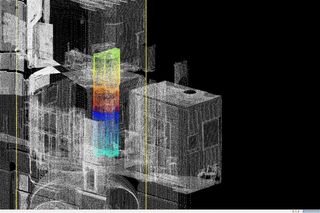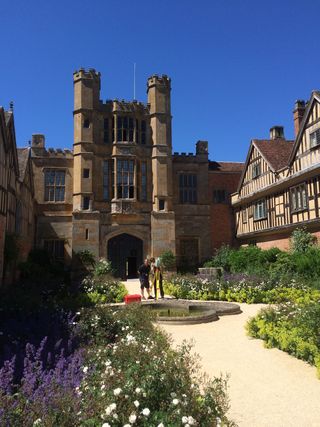Secret Room in UK Mansion Tied to King James I Assassination Attempt

Agile scientists equipped with 3D laser scanners have revealed the secrets of a hidden room, known as a "priest hole," in the tower of an English Tudor mansion linked to the failed "Gunpowder Plot" to assassinate King James I in 1605.
A new study reveals how the secret double room was constructed in the tower of a gatehouse at Coughton Court in Warwickshire, as a hiding place for priests during the anti-Catholic persecutions of the 16th and 17th centuries.
Catholic priests faced execution as traitors under the English laws of the time, and they were often tortured to reveal their accomplices, according to Christopher King, an assistant professor in the Department of Archaeology at the University of Nottingham in the United Kingdom, and one of the lead researchers of the study. [See More Photos of the Secret "Priest Hole" at Coughton Court]
Despite being outlawed, many priests chose to travel around England in disguise and perform the banned Catholic ceremonies in secret, often at the country homes of wealthy Catholic families such as Coughton Court, he said.
The secret priest holes were ingeniously constructed inside walls and between floors, as places where a priest could hide from search parties while the family of the house pretended to go about their normal lives, King told Live Science. The priest hole at Coughton Court was rediscovered by later owners in the 1850s.
"We know that priests were hiding in these spaces for up to three days while people were searching the properties," he said, "and some of them are really very small, where the priest would be in quite an enclosed box-like space."
Double-blind
Sign up for the Live Science daily newsletter now
Get the world’s most fascinating discoveries delivered straight to your inbox.

To learn more about how the priest hole was constructed and hidden from searchers, King and his colleagues used 3D laser scanning equipment to precisely map the secret chambers and determine their location in relation to the rest of the building and its grounds.
The composite images and 3D computer models generated from the laser scans show the chamber's "double-blind" construction, which was designed to fool searchers into thinking they had found an empty priest hole, King said.
"When they're searching, they think they've found the priest hole but it's empty, but actually the priest is hidden in the more concealed space beyond," he said. "And that's what happens at Coughton: there's one chamber under the floor in the turret of the tower, and then there is another trap door that goes through into a second space, which we assume is where the priest was actually hiding." [10 Biggest Historical Mysteries That Will Probably Never Be Solved]
The restricted size of the priest hole presented a challenge for King and his colleague Lukasz Bonenberg, a geodesy and mapping specialist at the University of Nottingham's Geospatial Institute.
"They are quite narrow, probably about a meter [3.3 feet] across, and quite tall and thin. It was difficult to get the scanner in there, and Lukasz ended up spending a couple of hours down there with the equipment, basically because he's the skinniest," King said.
Gunpowder Plot
In 1605, Catholic resentment over England's anti-Catholic laws inspired the Gunpowder Plot, a conspiracy to assassinate King James I by blowing up the House of Lords at Westminster while the king and his government ministers were inside.
King explained that Coughton Court played a role in the plot when it was rented as a family home by Sir Everard Digby, who was one of the Catholic conspirators along with Robert Catesby, their leader, and Guy Fawkes, who became the most famous of the plotters.
On the date agreed by the plotters for the assassination, Nov. 5, 1605 — now commemorated as "Guy Fawkes Night" in the U.K., complete with bonfires and fireworks — a group of leading Catholic conspirators met at Coughton Court to wait for news of the attempt to kill the king. [
But when the messenger reported that the plot had been discovered and many of the plotters had been captured, the conspirators who had gathered at Coughton Court fled into the night. Most were captured and executed in the years that followed, King said.
Coughton Court is now owned by the heritage charity National Trust, which keeps most of the historic property open to the public, including the tower that contains the priest hole. But the tower itself is inaccessible to many people, King said.
"The scans and the fly-throughs that we've created will be really good for people who can't get up the stairs to the priest hole — you can stand in the courtyard with these images and it really helps you visualize where the space is," he said.
The initial study at Coughton Court was funded by Britain's National Lottery, and King now hopes to expand the research project by investigating other priest holes in historic houses in England. Around 30 are known to exist, but many are not open to the public and most are deliberately difficult to access, he said.
"That's really important from a public outreach point of view: making sure that visitors are aware of these spaces and their very interesting histories, and, hopefully, getting people interested in the stories associated with the buildings," King said.
Original article on Live Science.
Tom Metcalfe is a freelance journalist and regular Live Science contributor who is based in London in the United Kingdom. Tom writes mainly about science, space, archaeology, the Earth and the oceans. He has also written for the BBC, NBC News, National Geographic, Scientific American, Air & Space, and many others.

